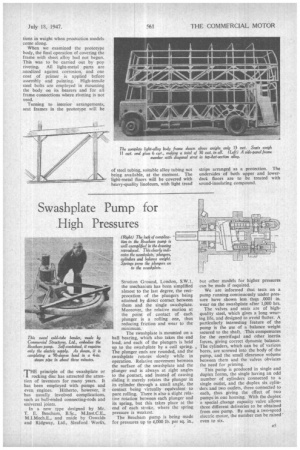Swashplate Pump for High Pressures
Page 39

If you've noticed an error in this article please click here to report it so we can fix it.
THE principle of the swashplate or rocking disc has attracted the attention of inventors for many years. It has been employed with pumps and even engines. Hitherto, however, it has usually involved complications, such as ball-ended connecting-rods and universal joints.
In a new type designed by Mr. T. E. Beacham, B.Sc., Minst.C.E., M.I.Mech.E., and made by Oswalds and Ridgway, Ltd., Sleaford Works, Strutton Ground, London, S.W.1, the mechanism has been simplified almost to the last degree, the reciprocation of the plungers being attained by direct contact between them and the single swashplate. Moreover, the relative motion at the point of contact of each plunger is a rolling one, thus reducing friction and wear to the minimum.
The swashplate is mounted on a ball bearing, which also takes the end load, and each of the plungers is held up to the swashplate by a coil spring. The plunger. ends are rounded, and the swashplate rotates slowly while in operation. Relative movement between the surface of the swashplate and the plunger end is always at right angles to the contact, and instead of causing sliding it merely rotates the plunger in its cylinder through a small angle, the contact being virtually equivalent to pure rolling. There is also a slight relative rotation between each plunger and its spring, but this takes place at the end of each stroke, where the spring pressure is weakest.
The Beacham pump is being made for pressures up to 6,000 lb. per sq. in., but other models for higher pressures can be made if required.
We are informed that tests on a pump running continuously under pressure have shown less than .0001 in. wear on the swashplate after 1,000 hrs.
The valves and seats are of highquality steel, which gives a long wearing life, and designed to avoid flutter. A particularly interesting feature of the pump is the use of a balance weight secured to the shaft. This compensates for the centrifugal and other inertia forces, giving correct dynamic balance.
, The cylinders, which can be of various bores, are screwed into the body of the pump, and the small clearance volume between them and the valves obviates the need for priming.
This pump is produced in single and duplex forms, the single having an odd number of cylinders connected to a single outlet, and the duplex six cylinders and two outlets, three connected to each, thus giving the effect of two pumps in one housing. With the duplex a special change capacity valve allows three different deliveries to be obtained from one pump. By using a two-speed electric motor, the number can be raised even to six.




















































































